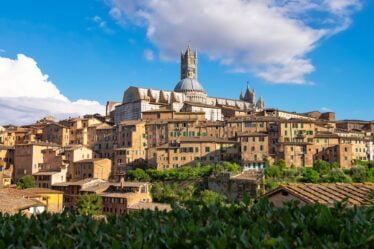

1. The Origins and Early Convent Life (1370–19th Century)
The Monastery of Santa Maria Annalena delle Murate was founded in 1370, initially established by a group of women who sought a secluded and contemplative life. These women lived in voluntary isolation within the walls of Florence, hence the term “Murate,” which means “walled-in.”
The nuns followed the Benedictine rule, which imposed strict vows of poverty, chastity, and seclusion. The convent became one of the most important religious centers in Florence, reflecting the city’s deep connection to spirituality during the Middle Ages and Renaissance.
2. Architectural Development
Over time, the complex expanded to accommodate the growing number of nuns. It was enriched with chapels, cloisters, and living quarters. The architectural style of the Murate is a mix of medieval and Renaissance elements, with simple, functional designs reflective of the nuns’ lifestyle, but also with ornamental features such as frescoes and altarpieces donated by wealthy Florentine patrons.
By the 15th century, it had become a significant and prosperous institution, benefiting from the patronage of influential Florentine families, who often sent their daughters to become nuns there. The convent was also known for its educational activities, with the nuns teaching music, embroidery, and religious studies.
3. Napoleonic Suppression and Secularization (19th Century)
In 1808, when Napoleon’s troops invaded Italy, they brought with them the suppression of monastic institutions. Many convents and monasteries, including the Murate, were disbanded. The nuns were forced to leave, and the buildings were seized by the state.
The monastery’s suppression marked a major change in its purpose. After the religious order was disbanded, the once-sacred space began its transformation into secular use.
4. Conversion into a Prison (1832–1985)
In 1832, the Murate complex was converted into a prison under the Grand Duchy of Tuscany. It became the Florence State Prison, which housed a variety of inmates, from common criminals to political prisoners. During this period, many of the convent’s religious features were removed or modified to suit its new function as a detention center.
The prison gained notoriety during the Fascist regime of Benito Mussolini in the 20th century. Anti-Fascist activists and political opponents were incarcerated here, making it a symbol of resistance. Notably, during World War II, members of the Italian resistance, including partisans and political dissenters, were held in Murate under extremely harsh conditions.
It remained a prison throughout much of the 20th century until 1985, when it was closed due to the dilapidated state of the structure. Its closure marked the end of one of Florence’s most significant penal institutions.
5. Decay and Neglect (1985–1990s)
After the prison closed, the complex fell into disrepair. For many years, it was abandoned, and its historical value seemed neglected. During this time, the site became a symbol of urban decay, with overgrown vegetation and deteriorating buildings.
6. Restoration and Modern Development (2000s)
A revival began in the 2000s when the Florentine city government undertook an ambitious restoration and redevelopment project. The idea was to transform this once-sacred and later notorious space into a modern, mixed-use urban complex while preserving its rich historical layers.
Restoration works preserved much of the original architectural features, including the prison cells and historical details like iron bars on windows, while blending modern structures into the existing framework.
7. Murate Today: A Cultural and Social Hub
Today, Le Murate is a vibrant space that serves as an artistic, residential, and cultural center. The restored complex now includes:
- Residential Apartments: Part of the complex has been turned into affordable housing, integrating modern living spaces within the historic walls.
- Art Spaces: Le Murate is home to the Murate Art District (MAD), which hosts art exhibitions, cultural programs, workshops, and performances. This has made it a key player in Florence’s contemporary art scene.
- Public Spaces: The complex also features cafes, restaurants, and public squares that create a lively atmosphere for locals and tourists. The central courtyard, which was once a place of confinement, now serves as a venue for outdoor concerts, cultural festivals, and social gatherings.
- Historical Remnants: Visitors can explore parts of the prison and learn about its history through exhibitions and guided tours. The preserved cells and graffiti left by prisoners stand as a reminder of its dark past.
8. Social and Historical Importance
Le Murate’s transformation from a religious institution to a prison and now to a cultural hub reflects Florence’s evolving social history. The complex is a symbol of resilience and the continuous reinvention of urban spaces. Today, it functions not only as a historical monument but also as a thriving center for dialogue, creativity, and community engagement.
Final Thoughts
Le Murate is a unique blend of Florence’s medieval, Renaissance, and modern history. Its evolution from a place of religious isolation to a notorious prison, and finally to a center of culture and creativity, makes it a compelling destination for those interested in the city’s multifaceted past.


